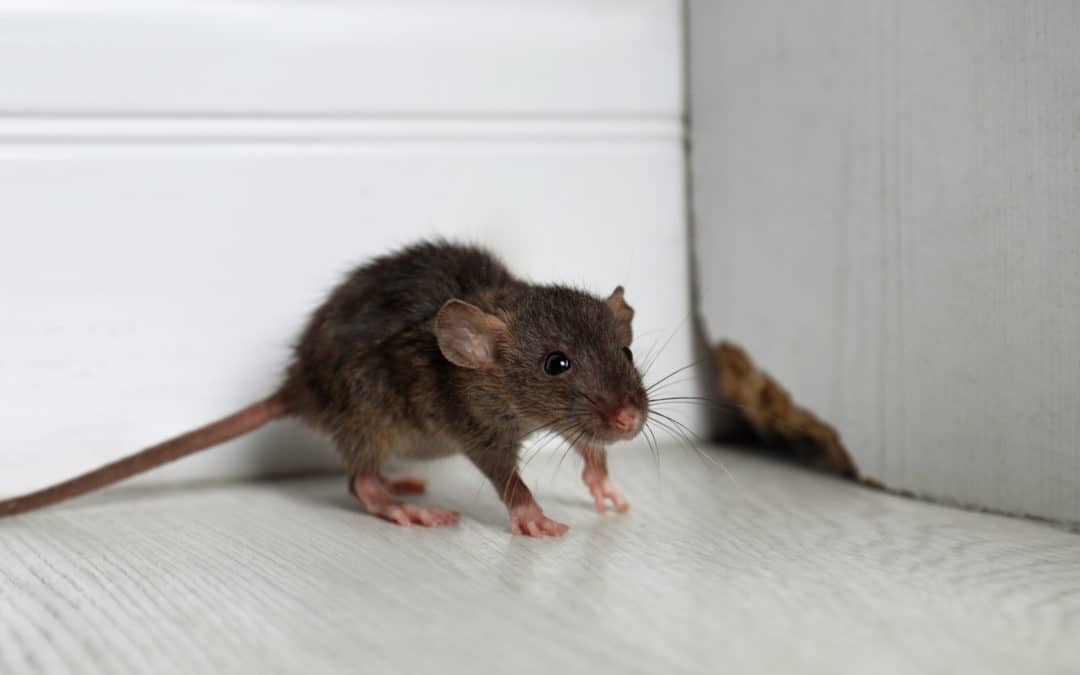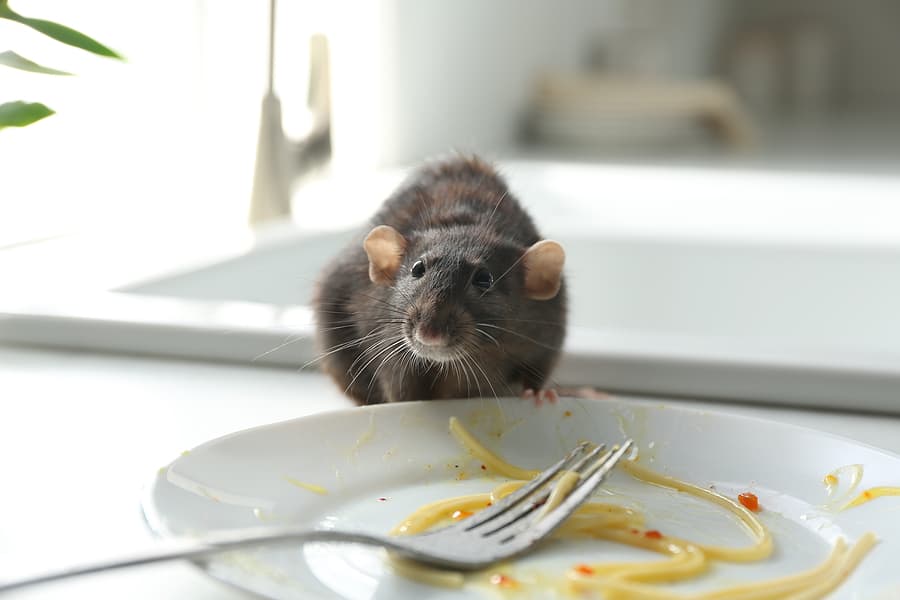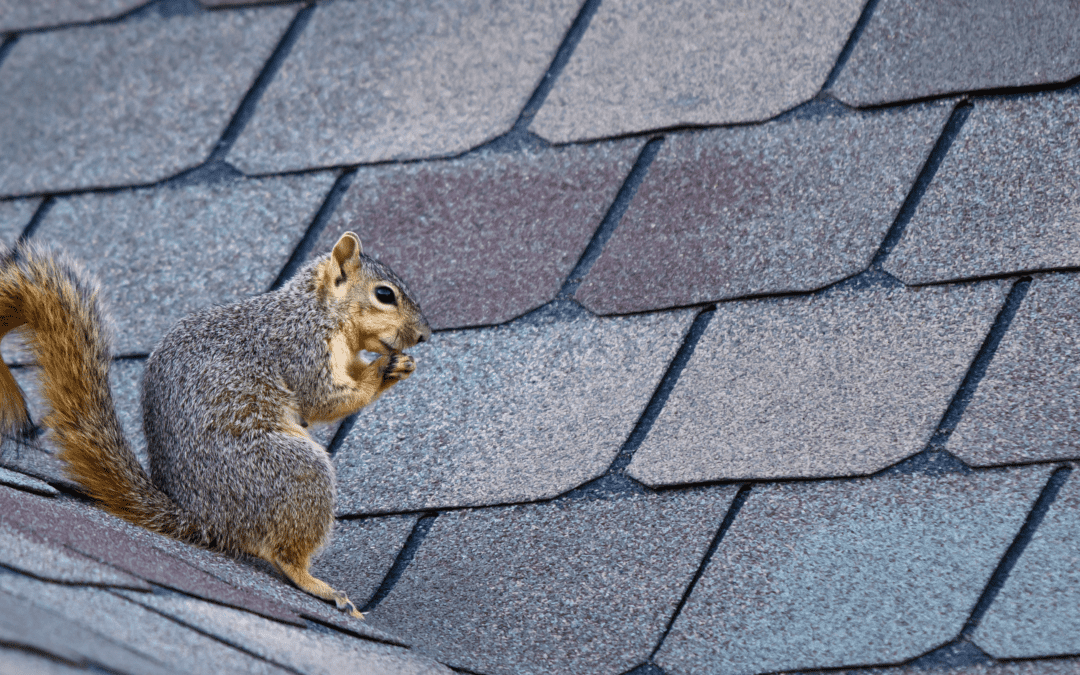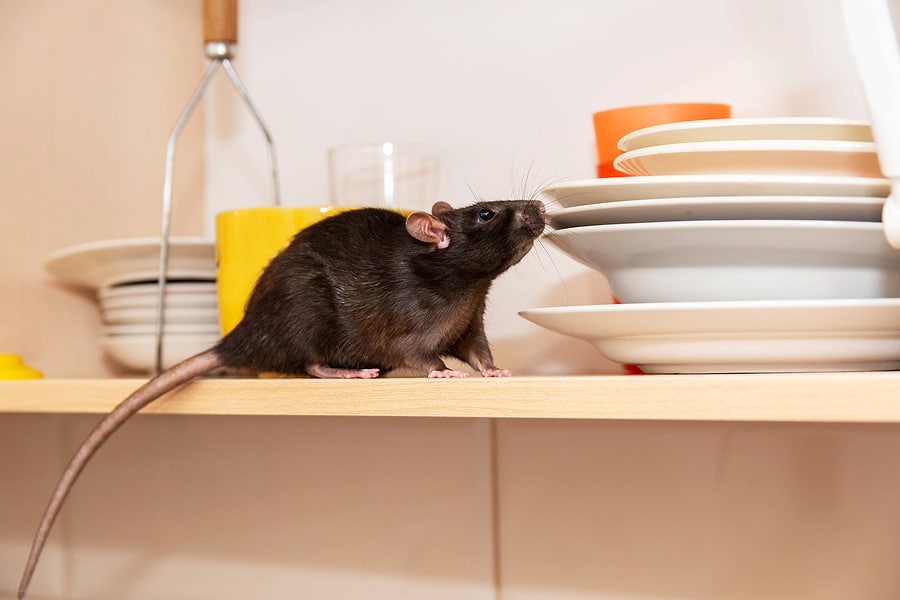READY TO GET STARTED?
REQUEST A FREE ESTIMATE
Fill out the form below or call (888) 466-7849 for a free, no-obligation estimate.

Rats are one of the most destructive household pests, chewing through wires, walls, and insulation and contaminating your home with their feces and urine. They also carry some pretty serious diseases, putting both you and your family at risk. These risk factors make identification and rodent control an important part of your household pest control plan.
Rats are mostly nocturnal pests and it is rare for them to come out during the day. Their activity typically begins around dusk. Because rats commonly inhabit areas near humans, it is safer for them to come out after dark when there is less chance of them being caught. They will make an appearance during the daytime if they feel safe enough to do so and especially if food supplies are scarce.
If they aren’t coming around during the day, where are they hiding? Rats prefer to hide in places that are tucked out of the way and that aren’t often disturbed. Outdoors they will hide under piles of debris, under trash piles, in dumpsters and trash cans, in trees, and in sewers. They can also be found under bushes and shrubs, in woodpiles, and in gutters. Inside, rats can be found hiding out in holes, cracks, and crevices; climbing up through drains in bathrooms and kitchens; behind cabinets; behind and under appliances; in air ducts and ventilation systems; in piles of clutter; in storage containers; in hollow walls; and in crawlspaces, attics, garages, and basements.
Seeing a rat during the day can be an indication of a larger rodent infestation. Seeing one rat may not be cause for alarm; seeing more than one or seeing one in conjunction with other signs of rodents can be cause for concern. Some common signs of a rodent infestation include rat droppings, especially in one specific area; chew marks or chewed through wires, food packages, and other household surfaces; nesting material like fabric and paper; and a musty smell.
If you suspect you have a problem with rats or any other rodents, contact your local pest control company who can provide you with a thorough evaluation and an ongoing treatment and prevention plan to keep your home pest free.
Winter Lawn Care Tips for Your Georgia Lawn

Rodents such as mice and rats are one of the most common household pests. While they are definitely nuisance pests, they can also cause property damage to your home, as well as transmit serious diseases to you and your family.
The first step in rodent control is to determine that you have an infestation. Common signs of rodents include droppings near food sources; shredded paper, fabric, and other nesting materials; chewed food packages; holes chewed through walls and floors; and stale smells from hidden areas of your home.
Rodents are attracted to unsealed food containers, pet food and water that’s left out, open bowls of fruit and vegetables, leaky faucets and pipes, open trash cans, and compost containers among other things. They enter your home in search of these things. They get in through holes from the exterior of the home, holes around sink and appliance pipes, cracked foundations, unscreened vents, and holes around windows and doors.
The first step in rodent control for your home is prevention. If you can keep these pests from infesting your home in the first place, you won’t have to get rid of them later. Common rodent control methods you can utilize in your house include:
If you have a problem with rodents or other pests, contact your local pest control company for an evaluation.
DIY Pest-Proofing for Fall Wildlife
Are Granddaddy Long Legs Spiders?

Wildlife creatures can be cute from afar, but once they’ve invaded our homes, they quickly become a nuisance! While wildlife typically invade homes in the winter, they are still highly active in the summer, as well, searching for food and water sources. Check out our list of common wildlife creatures in Pompano Beach and how you can prevent them.
Active year-round, rats are excellent climbers and will adapt to human environments. They often seek out undisturbed areas such as attics, basements, and crawlspaces. For survival, these rodents will need a food source and will look in your home for grains, nuts, fruits, seeds, and vegetables. Harmful to humans, rats are known to contaminate food, cause fire hazards by chewing wires, and leave their droppings that can lead to disease.
During the summer, opossums are actively hunting for food for their young. During the day, these pests will hide in trees until the evening arrives. As nocturnal pests, opossums look for their food source primarily at night. Opossums will scour your trashcans for nuts, fruits, grains, and even insects.
Raccoons give birth to their young during the summer and, like opossums, they are actively looking for food for their babies. While raccoons prefer wooded areas to inhabit with trees, water, and vegetation, they can be found in human areas too. They often seek out shelter in our attics, barns, and sheds. Raccoons are also nocturnal, searching for food at night. These creatures eat fruits, nuts, seeds, fish, and even snakes. Raccoons can become a nuisance if they find their way onto our property, often knocking over garbage cans or destroying gardens.
Preventing wildlife starts with the preventative measures put in place around your home. Consider utilizing these do-it-yourself wildlife control tips:

August is here and as much as we don’t want to think about it, fall is right around the corner. As the days begin to get shorter and temperatures drop, wildlife creatures begin to prepare for the fall and winter seasons. Fall is the time when wildlife search for warm shelter and begin to stock up on food, sometimes leading them right to your home!
Here are some of the most common wildlife critters that can find refuge in your home for winter, along with some ways to prevent them from taking up residence in your home.
Squirrels like to “fatten” up in the fall as they get ready for the colder months. They often seek shelter in attics where they will make their nests and store their food. They are especially hazardous in homes because they have a tendency to chew through wires and wood, creating significant damage to your home.
Some ways to prevent squirrels:
Like squirrels, raccoons also like to “fatten” up for the winter. Raccoons are nocturnal, which means they are more active at night. When the weather gets cooler, this causes raccoons to become more active and creative in their search for food. They will often find food in your trash cans and home and can often enter your house through the roof. They are known to seek shelter in either your attic or crawl space.
You can prevent raccoons by:
Rodents, like mice and rats, will begin to be more active in the fall and you can usually hear them in your walls or attic. They seek shelter in your home because it supplies them with an available food supply throughout the winter.
Prevent rodents this fall by:
Bats
Once the temperature dips below 45 degrees Fahrenheit, bats will begin their hibernation. While some species of bats do migrate south once the weather cools off, some will be in search of warm, dark spaces to roost that are hidden from predators. Unfortunately, they will often roost in the attic or chimney of your home.
You can prevent bats by:
Wildlife removal can be a difficult task to handle on your own, as there are some regulations for certain species. It is often best left to the professionals. If you suspect you have a wildlife problem, contact your local professional wildlife control company. These professionals will inspect your home to identify the animal problem. They will also provide you with the best plan of action to remove nuisance wildlife and prevent it in the future.

As members of the rodent family, mice and rats look very similar and are often mistaken for one another. Both are harmful, transmitting serious diseases to humans and pets, contaminating surfaces in our home, and chewing through structures and wires, causing damage and putting you at risk for fires. How do you know if you are dealing with a mouse vs rat? Here are 5 key differences between these two rodents.
Mice are noticeably smaller than rats, growing 3 to 4 inches in length. Mice weigh anywhere from 0.5 oz to 3 oz. A mouse’s tail is equal in length to its body and is thin, long, and covered in hair. Mice have small heads and large ears with pointy, triangular snots and smooth fur. Mice can be white, gray, or brown in color. Rats, on the other hand, are much larger, measuring 9″ to 11″ in length and weighing anywhere from 12 oz to 1.5 lbs. A rat’s tail can be 7″ to 9″ in length and is long, thick, scaly, and hairless. Rats have small ears and large heads with blunt snouts. They have coarse fur that can be dark brown or multicolored.
Mice have smaller droppings, about 1/4″ in length. Mice droppings are black with pointed ends and resemble a grain of rice. Mice can leave up to 100 droppings at a time. Rat droppings are larger with an elongated oval shape. These droppings are about 3/4″ long, black in color, and resemble a banana. Rats can leave up to 50 droppings at a time. Rodent droppings of both species are known to carry diseases that can be harmful to humans.
While both species are omnivores, their diets tend to vary. Mice commonly eat fruit, seeds, and plants. In your home they may nibble on bread crumbs or other cereals and grains. Their palates are not as wide as rats. Mice can also survive on 3 mL of water per day. Rats, on the other hand, will eat almost anything, even scavenging through your garbage for fruit, eggs, meat, and other leftovers. They will also eat plants and seeds. Rats need anywhere from 15 to 60 mL of water per day.
While both rats and mice will come into your home, they tend to frequent different areas once inside. Mice can be found in garages, under trees, under decks, and in walls and other voids that are too small for other rodents to get into. The species of rat you are dealing with determines where they prefer to live. Norway rats can be found in sewers, inside walls, and in cellars. They prefer lower levels of your home to reside in. Roof rats prefer higher environments, often being found in cabinets and attics.
Mice are nocturnal animals. They are timid but social within their own populations. They are very territorial and more curious than rats, making them easier to trap. They are skillful climbers and can access areas rats can’t because of their small size. Rats are also nocturnal but are more cautious and fearful of new things than mice are, making them more difficult to trap. Rats are also skillful climbers. Both rats and mice will gnaw through structures and wiring in your home, causing damage and putting you at risk for fire. Mice have weaker teeth and can’t chew through glass or metal to get to food. Rats have much stronger jaws and have been known to chew through wood, glass, sheet metal, aluminum, and even cinder blocks.
Regardless of which pest you are dealing with, proper identification and treatment is essential to eliminating them. Contact your local pest control company who can determine which type of pest you have and set you up with the appropriate rodent control plan to eliminate them.
Cockroaches: Types and Prevention Tips